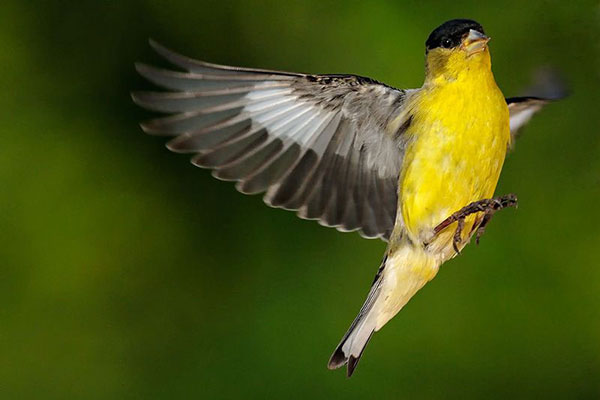The American goldfinch (Spinus tristis) is a small North American bird in the finch family. It is migratory, ranging from mid-Alberta to North Carolina during the breeding season, and from just south of the Canada–United States border to Mexico during the winter.
The American goldfinch prefers open country where weeds thrive, such as fields, meadows, flood plains, as well as roadsides, orchards, and gardens. It may also be found in open deciduous and riparian woodlands and areas of secondary growth. This habitat preference continues during the spring and autumn migrations.
The summer breeding range stretches across North America from coast to coast. It is bounded on the north by Saskatchewan and stretches south across North America to North Carolina on the east coast, and northern California on the west coast. The American goldfinch is a short-distance migrant, moving south in response to colder weather and lessened food supply. This responsive, southerly migratory pattern is thought to begin to occur as daily low temperatures approach freezing, and particularly as these temperatures near 0 °F. The migration is completed in compact flocks, which travel in an erratic, wavelike flight pattern.
The American goldfinch flies in a distinctive undulating pattern, creating a wave-shaped path. This normally consists of a series of wing beats to lift the bird, then folding in the wings and gliding in an arc before repeating the pattern. Birds often vocalize during the flapping phase of the pattern and then go silent during the coasting phase. The call made during flight is "per-twee-twee-twee", or "ti-di-di-di", punctuated by the silent periods. They communicate with several distinct vocalizations, including one that sounds like "po-ta-to-chip" to the listener.
Birds do not act aggressively toward predators within their territory; their only reaction is alarm calling. Predators include snakes, weasels, squirrels, and blue jays, which may destroy eggs or kill young, and hawks and cats, which pose a threat to both young and adults. The oldest known American goldfinch was 10 years and 5 months old.
The American goldfinch is gregarious during the non-breeding season when it is often found in large flocks, usually with other finches. The social hierarchy, measured by how many aggressive encounters are won by each individual, tends towards the male being dominant in the non-breeding season. During the breeding season, this finch lives in loose colonies. While the nest is being constructed, the male will act aggressively toward other males who intrude into his territory, driving them away, and the female reacts in the same way toward other females. This aggressiveness subsides once the eggs have been laid. The social hierarchy in the breeding season generally has the female dominant over the male.[31] Dominance may change based on the value of a resource; a study published in 1987 found that starved subordinate birds were sometimes dominant in competitions over feeder access.
The breeding season begins later in the year than for any other finch and later than any other native North American bird, besides occasionally the sedge wren. This may be related to the abundance of seeds in the late summer months, as seeds represent most of their diet.
The courtship rituals include aerial maneuvers and singing by males, who begin courtship in late July. The flight displays begin as the male pursues the female, who flies in zigzagging evasive patterns. The male can signal his quality and fitness, both in the short term (current body condition) and long term (genes), through ornamentation (bill color and plumage). If a female accepts the male as a mate, the pair will fly in wide circles, as the male warbles throughout the flight.
The American goldfinch is a diurnal feeder. According to the Cornell Lab of Ornithology, the species is one of the strictest vegetarians in the bird world. It is mainly granivorous, but will occasionally eat insects, which are also fed to its young to provide protein. Its diet consists of the seeds from a wide variety of plants, often those of weeds, grasses, and trees, such as thistle, teasel, dandelion, ragweed, mullein, cosmos, goatsbeard, sunflower, and alder. However, it also consumes tree buds, maple sap, and berries. It will eat at bird feeders provided by humans, particularly in the winter months, preferring Niger seed (commonly and erroneously called thistle seed).
Unlike some finch species, the American goldfinch uses its feet extensively in feeding. It frequently hangs from seedheads while feeding to reach the seeds more easily. In the spring, the American goldfinch feeds on the catkins hanging from birches and alders by pulling one up with its beak and using its toes to hold the catkin still against the branch. This dexterity enables it to take advantage of food sources relatively inaccessible to potential competitors, increasing its chances of survival.
